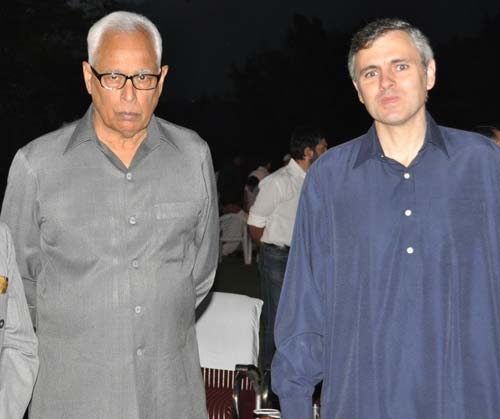In his first stint, Governor NN Vohra successfully handled the alarming situation that had emerged in Kashmir valley. For New Delhi, he has donned the robes of a school principal who knows how to impose discipline in a classroom. It is this unassuming authority, impeccable understanding and polished negotiating skills that Vohra has been reelected as J&K Governor, Shah Abbas reports.

After successfully “dealing” with two chief ministers and witnessing three consecutive uprisings in just five years of his tenure, J&K Governor Narinder Nath Vohra was last week re-elected as the constitutional head of the state. It is his “remarkable” role that has made him New Delhi’s “ideal man” for Kashmir. Vohra was appointed as Governor for a fresh five-year term on April 26, 2013. His term was to end on June 25 this year.
Over the last five years, a remarkable achievement of Vohra has been his role of an intermediary between New Delhi and Srinagar. As National Conference parliamentarian Dr Mehboob Beigh puts it, “Vohra knows the ins and outs of the Kashmir problem.” His experience in dealing with the issues and being non-controversial led New Delhi to continue with Vohra as its representative in the state.
A recipient of Padma Vibushan, Vohra guided the affairs in a sensitive state like J&K with a “balanced approach” and by keeping almost all the stakeholders together. “He is an experienced hand and for the time being the only hand dealing Kashmir in different capacities,” said CPI (M) state Secretary, M Y Tarigami adding that it was these qualifications which led to his reelection as J&K Governor.
Vohra was appointed by the previous NDA government as the Centre’s point man for J&K in February 2003. He held talks with various groups in the state that paved way for talks between former Deputy Prime Minister LK Advani and Hurriyat Conference (M), the first-ever formal interaction between the Centre and Kashmir’s separatist leadership.
Vohra replaced KC Panth, then deputy chairman of the Planning Commission, who held talks with various political outfits in Jammu and Kashmir when Dr Farooq Abdullah was J&K’s chief minister. Though Pant wanted to continue with his assignment but, according to reliable sources, Mufti Mohammad Sayeed who had taken over as J&K’s Chief Minister did not think he was appropriate to conduct discussions with various parties involved in Kashmir imbroglio.
Vohra is known for his contacts in separatist camp especially Hurriyat (M). “Vohra is so close to some of the separatist leaders that when he took over as Governor of the state in 2008 and the situation was brewing, a family member of a Hurriyat leader called him to ensure safety of the leader as he was leading a protest march,” said a senior bureaucrat claiming that he was with Vohra when he received the call.
The bureaucrat added that Vohra is a very active Governor who always takes “classes of the bureaucrats” at Raj Bhawan. “If J&K is a school, then Vohra is its headmaster who always takes government to task. He even asks for monthly reports about developmental projects from the chief minister.”
Vohra, a former Punjab cadre IAS officer, was the first person without Army or intelligence background to occupy the post in the state since Jagmohan, who demitted office in 1990. Jagmohan was replaced by former RAW chief Girish Chandra Saxena who was succeeded by Gen KV Krishna Rao (retd) in 1993. However, Saxena returned to the post in 1998 till Lt Gen SK Sinha took over in 2003.
When Vohra was called in to take charge in Kashmir, his predecessor Sinha had created a huge mess in Jammu and Kashmir which had created problems for New Delhi and ultimately gave birth to a mass uprising against Indian rule in Kashmir valley. When Peoples Democratic Party (PDP) withdrew its support from the coalition government, Ghulam Nabi Azad, resigned as the chief minister on July 10, 2008. Vohra waited for month and a half before he came out with his “counter-ragda” to stop the protests. He started with undeclared curfew on August 24, 2008. At the peak of 2008 agitation on August 22 when the separatists had given a call for people to gather at the historic Eidgah grounds, Vohra himself flew over Eidgah in a helicopter to access the situation on ground.

